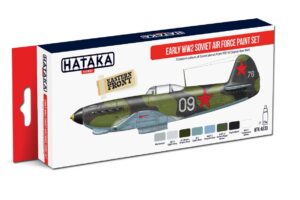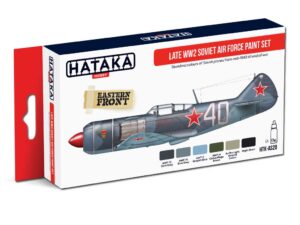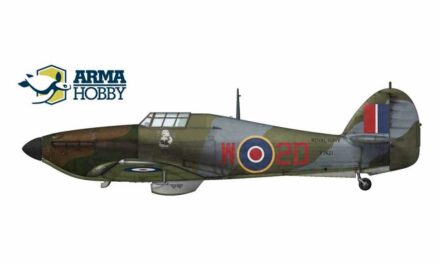Yakovlev Yak-1b was the most effective fighter aircraft used by the Soviet Voyenno-Vozdushnye Sily in the first part of the Second World War. When new Soviet fighter aeroplanes appeared, i.e. Yak-9 and La-7, Yak -1b was moved to reconnaissance missions and to escort ground-attack aircraft. Allied units – first French also used it, then Polish and, in the end, Yugoslav.
Yak-1b, No 23, squadron GC3 “Normandie” Monostirshchina airfield, October 1943. Artwork by Oskar Gawłowski.
Yaks with Tricoleur – France
The first foreign user was French Armee de l’Air. The “Normandie” squadron, later reorganised as an aviation regiment “Normandie-Niemen”, was formed at the turn of 1942 and 1943, during the final stage of the Battle of Stalingrad. Its staff consisted of French pilots who had previously served with the Royal Air Force and those who came from liberated French colonies. The unit started combat service in the spring of 1943, with its aircraft still wearing winter camouflage, and soon became famous for its gallantry during the Battle of Kursk in 1943. Unlike other allied units which used Yak-1b fighters, French pilots mainly flew fighter missions.
Yak-1b, No 44, GC3 Normandie, pilot Marcel Albert, March 1943. Aeroplane in factory Winter finish of green upper surfaces were covered with washable white paint and undersurfaces were blue-grey . Visible French roundel under cockpit, and GC1 insignia – original unit of the pilot. Markings from 70028 Yak-1b Model Kit. Artwork by Zbyszek Malicki.
Planes received by the French unit wore French roundels in front of the cockpit. Many of them had foundation inscriptions written in red on white, washable paint which was covering aircraft fuselages. Factory fresh aircraft built during the winter of 1942/43 had upper surfaces painted green and lower surfaces painted light blue-grey, and temporary white-wash was applied over green colour. When winter camouflage was removed, fighters received irregular black patches on upper surfaces. That’s why every aircraft in the unit looked different – for example; there were additional black stripes or fish scales painted on their surfaces.
Yak-1b, No 6, GC3 Normandie, pilot Albert Durand, Khatenki airfield, Summer 1943. After remowing Winter “white-wash” green uppersurfaces were painted with black disruptive pattern (different from factory pattern). Markings from 70027 Yak-1b Expert Set. Artwork by Zbyszek Malicki.
Apart from typical French roundels, French Yaks-1b wore other markings – propeller spinners in French colours, unit emblems or pilots personal markings. The most characteristic feature was the white arrow/lighting on the fuselage sides. It is also known from unit’s Yak-3 fighters, and it had been probably borrowed from 303rd Fighter Aviation Division VVS USSR to which French unit was assigned.
Yak-1b, No 23, GC3 “Normandie”, Monostirshchina airfield, October 1943. Aeroplane features French roundel, tri-colour spinner and a lightning insignia of 303 Fighter Aviation Division. Markings from kit 70029 Yak-1b Allied Service. Artwork by Zbyszek Malicki.
Jak-1b, No 33, GC3 “Normandie”, lotnisko Khatenki airfield, July 1943, pilot Noel Castelain. Four kill markings under cockpit and personal insignia of the pilot are visible after the French roundel. Markings from kit 70029 Yak-1b Allied Service. Artwork by Zbyszek Malicki.
Yaks-1b were withdrawn from the French unit at the end of 1943 and replaced first by Yak-3 and then Yak-9 fighters.
Yaks – 1b with white and red checkerboard – Poland
Polish turn to fly Yaks came after the French pilots had already been considered a well known and recognised war heroes. While the Soviets were forming the 1st Infantry Division of Polish Army, commonly known as “people’s”, supporting units were being formed too – the 1st Tank Regiment and the 1st Fighter Aviation Regiment “Warszawa”. The 1st FAR was the only Allied unit which was trained from the beginning according to the Soviet standards.
 Yak-1b, No 4, 1st squadron, 1 FAR, W/O Edward Chromy, Zadybie Stare airfield, Summer 1944 r. Aeroplane features yellow spinner of 1st squadron. Markings from 70027 Yak-1b Expert Set. Artwork by Zbyszek Malicki.
Yak-1b, No 4, 1st squadron, 1 FAR, W/O Edward Chromy, Zadybie Stare airfield, Summer 1944 r. Aeroplane features yellow spinner of 1st squadron. Markings from 70027 Yak-1b Expert Set. Artwork by Zbyszek Malicki.
Jak-1b, No 13, 2 squadron 1 FAR, with inscription “From Polish Patriot prof. Wolf-Messinga for Polish aviator” („От польского патриота проф. Вольф-Мессинга польскому летчику”), pilot Sgt. Hugon O’Brien, Berlin Operation, April-May 1945. Markings from 70027 Yak-1b Expert Set. Artwork by Zbyszek Malicki.
The biggest problem found during its formation was the lack of Polish pilots and specialists. NKVD murdered the majority of Polish officers who had been trained before the war, and it happened in 1940 during the Katyń Massacre. Those who survived left the USSR with Gen. Anders’s army and later fought in Italy where they took part in the Battle of Monte Cassino. The lack of Polish officers led to the situation when most of the officers in Polish aviation units in the USSR were Russians of real, or false, Polish ancestry. During the first combat mission made by the 1st FAR, only one of four pilots was a Pole (W/O E. Chromy, read more: link). Regiment’s main tasks were aerial reconnaissance and escort of attack aircraft of the 3rd Assault Aviation Regiment. Unit’s pilots didn’t achieve any victories while flying Yak-1b (they were achieved in the last month of the war when the regiment was using Yak-9 fighters).
Yak-1b, No 12181/12, 1 Fighter Aviation Regiment “Warszawa”, pilot Cpt. Oleg Matvieyev, 1944/45. Markings from 70029 Yak-1b Allied Service. Artwork by Zbyszek Malicki.
The aircraft used by the 1st FAR wore typical late-war camouflage consisting of two shades of grey on the upper surfaces and light blue-grey on the Lower. National insignia were red stars with factory painted silver borders. The same colour had tactical numbers, which were two last digits of serial numbers. If the first of two was 0, only the second was painted.
Yak-1b from 1 FAR after rehaul in 1945. Aeroplane in new Polish livery with national insignia. Markings from 70028 Yak-1b Model Kit. Artwork by Zbyszek Malicki.
Polish accent was white and red Polish Air Force checkerboard painted in front of the cockpit. Each squadron had a different colour of a spinner tip – the 1st squadron – yellow, the 2nd – white and the 3rd – blue.
One of the aircraft, founded by Prof. Wolf Messing had an inscription in Russian and (later Polish translation was added). The inscription was later moved to another aircraft. You can read about that aircraft in the article link.
After the war, Soviet stars were replaced by Polish Air Force checkerboards. In the second half of 1945, Polish Yaks-1b underwent overhaul and received a new camouflage – upper surfaces were painted green and lower light blue-grey.
Roundels with stars – Yugoslav Yaks -1b
Since the second part of 1944, pilots of Gen Broz-Tito’s the People’s Liberation Army of Yugoslavia flew Hurricanes Mk.IIc/IV and Spitfires Mk.V/IX in squadrons assigned to the RAF Balkan Air Force. In the spring of 1944, an agreement was reached between Tito and Stalin to train 300 Yugoslav pilots in the USSR. At the end of the year, it was decided to speed up the creation of new units and two Soviet aviation divisions were incorporated into Tito’s forces. The 236th IAD (Fighter Aviation Division) had three fighter regiments: 117th, 168th, 267th. Soon they were renamed – 236th division became 11th Aviation Division and regiments received new numbers – 111th, 112nd, 113rd. Yugoslav pilots were going to be trained in those units. They started flying combat missions in January, and their main tasks were to reconnoitre and escort of Il-2 ground-attack aircraft. They rarely met the enemy in the air and claimed no victories.
Yak-1b, No16173/34, 112 Fighter Regiment, Yugoslavia, May 1945. New Yugoslav markings are painted in place of Soviet starts and Guard insignia is left on engine covers. Markings from 70029 Yak-1b Allied Service. Artwork by Zbyszek Malicki.
Yugoslav aircraft had typical late-war camouflage – two shades of grey on the top and light blue-grey on the bottom. They kept Soviet markings, emblems and foundation inscriptions (e.g. Osvobozhdienny Donbas). In May 1945 Soviet stars were overpainted and replaced by Yugoslav stars in circles and flags on the rudder. During their renovation, top surfaces received green camouflage. However, worn aircraft were quickly disappearing from the Yugoslav units. The last aircraft was used at the beginning of the 50s in training.
Yak-1b camouflage colours 1942-1945
- Initial Black-Green camouflage: AMT-4 Camouflage Green, AMT-6 Black (disruptive pattern painted in factory from templates) and undersurfaces in AMT-7 Greyish Blue
- Aeroplanes manufactured in Winter 1942/43 were painted with: AMT-4 Camouflage Green on upper surfaces and AMT-7 Greyish Blue on lower surfaces, green was temporary overpainted with white-wash. In Spring the AMT-6 Black disruptive pattern was painted on green uppersurfaces. Every aeroplane was painted with different, improvised pattern.
- Since July 1943 until the end of war a “Grey Camouflage” was used on new aeroplanes: AMT-12 Dark Grey and AMT-11 Blue Grey uppersurfaces and AMT-7 Greyish Blue lower surfaces.
Colour sets suitable for Yak-1b
HTK-AS20 Late WW2 Soviet Air Force paint set – all camouflage colour excet white-wash.
HTK-AS33 Early WW2 Soviet Air Force paint set – early camouflage colours and white-wash
Both colour sets as well as separate colours you will find in Arma Hobby webstore (see link below)
Aknowlegements
Srecko Bradić, Oskar Gawłowski, Zbyszek Malicki. English translation by Dominik Sędziak.
You may be interested in:
- Yak-1b models and accessories in Arma Hobby webstore.
- Yak Anthology (Russian: Антология Як) website with wide selection of Yak-1/3/7/9 markings link
- Milan Micevski “Jakovjev Jak-1”, Aeroplan 1/90 str.: 4-14 (Serbo-Croatian language)
Modeller happy enough to work in his hobby. Seems to be a quiet Aspie but you were warned. Enjoys talking about modelling, conspiracy theories, Grand Duchy of Lithuania and internet marketing. Co-founder of Arma Hobby. Builds and paints figurines, aeroplane and armour kits, mostly Polish subject and naval aviation.
This post is also available in:
 polski
polski















